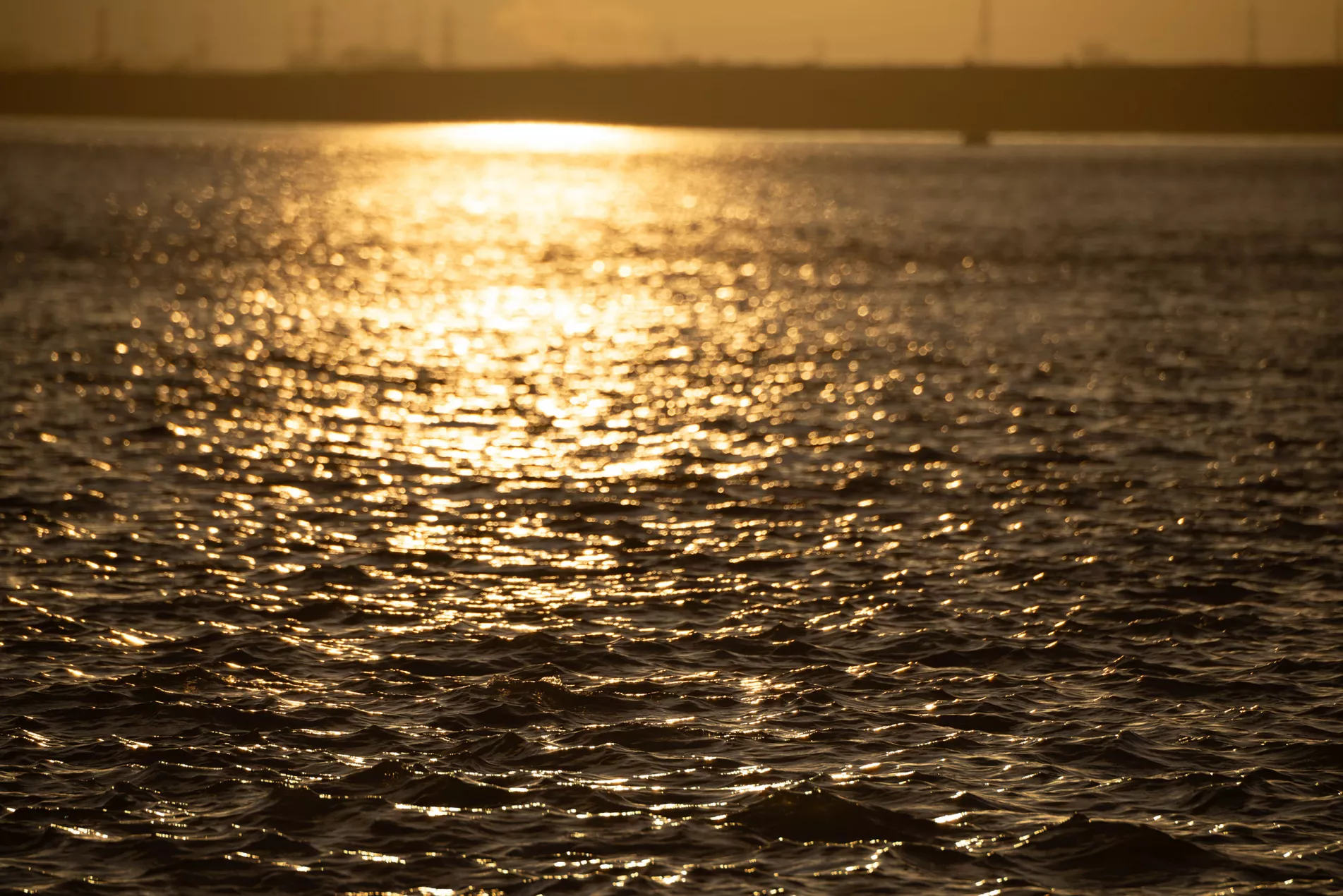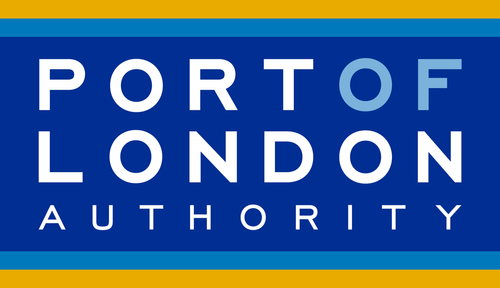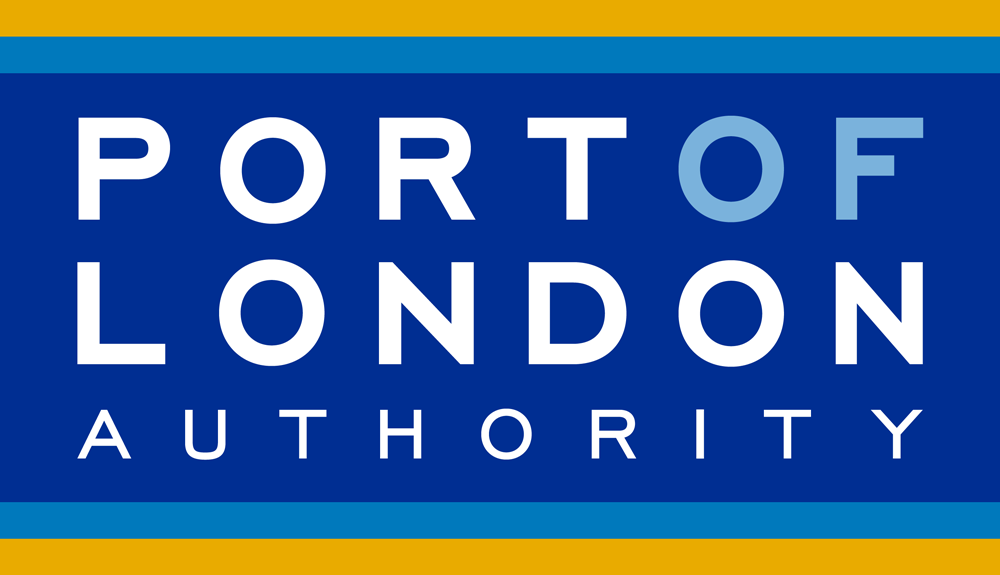Live Tides
NOTICES TO MARINERS
Charts & Surveys
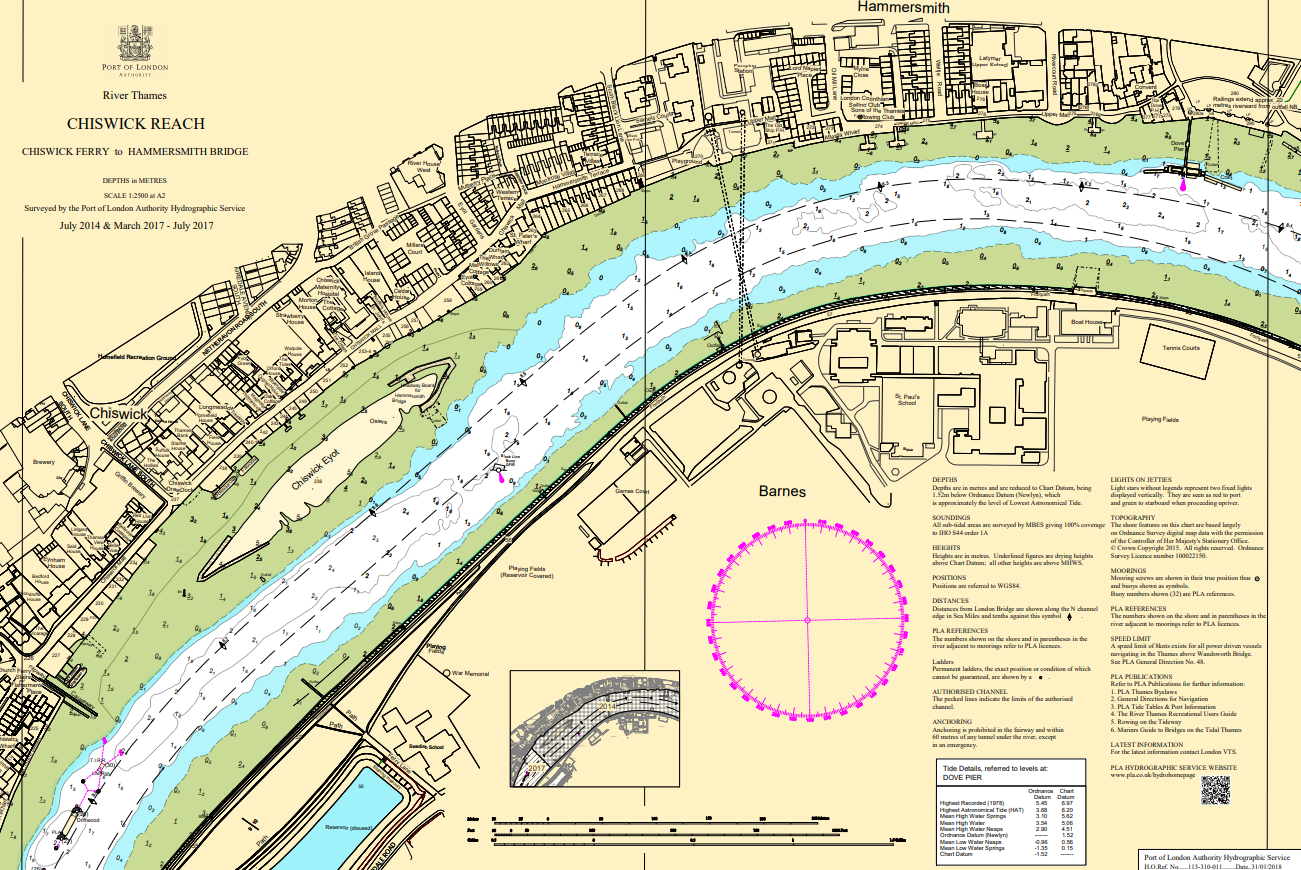
Incident reporting
Life-threatening emergencies on the river:
Call 999 and ask for the Coastguard
For near miss, safety observations and incident reporting click below
New trainee pilots recruited to support tidal Thames trade

Four more mariners with global experience have joined the Port of London Authority (PLA) to help ensure continued navigational safety for vessels visiting the UK’s busiest port.
They join a team of over 100 pilots, working round the clock to guide, in and out of port, the growing number of vessels navigating the tidal River Thames each year.
Last year, was the busiest ever for the PLA’s sea pilots. It saw them board almost 11,000 vessels navigating their way up and down the estuary, as trade recovered, following the COVID-19 lockdowns.
Adding to 12 PLA trainee pilots appointed in 2021, the new recruits have embarked on a five-year training programme, to equip them with the skills and knowledge essential for vessels’ safe navigation of the tidal Thames.
- David Barnett, from Cork, started his marine career aboard tankers in 2012, before moving to ferries. For the past three years, he has mainly worked on UK routes to Ireland and continental Europe.
- A Kent resident all his life, David R Hocking trained first as a Trinity House cadet. On qualifying, he worked as a deck officer on aggregate dredgers around Europe, predominantly on the Thames.
- Sailing the world with cruise line Holland-America for the first nine years of his career, Stuart Little joined Svitzer Marine in 2020, mainly operating tugs on the Thames and Medway. He moved to London from Preston four years ago.
- After graduating from Plymouth University, Adam Smith worked initially for the Seabourn Cruise Line, before joining Trinity House as a trainee cadet in 2013, rising through the ranks to become a master. He now lives in Dorking, Surrey.
The team’s work involves boarding and disembarking ships while underway, in all weathers and at all times of day and night, demanding a high level of training and safety awareness.
Bob Baker, chief harbour master at the PLA, said: “The addition of more new blood into our pilotage team not only helps meet growing demand, but will also ensure we can continue to offer a reliable service to our customers, as longer-serving pilots retire.”
Throughout the pandemic last year, the team delivered a 98.8 per cent service level to customers.
Related content
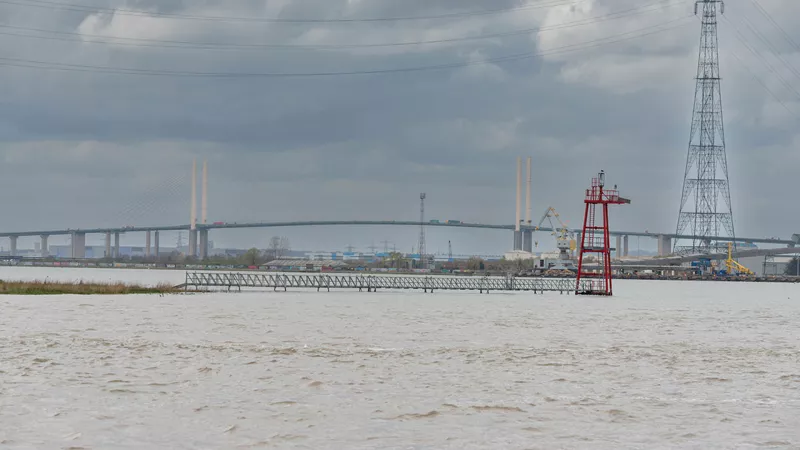

Location: London/Gravesend Remuneration: £28,971 per annum for a commitment of up to 24 days per...
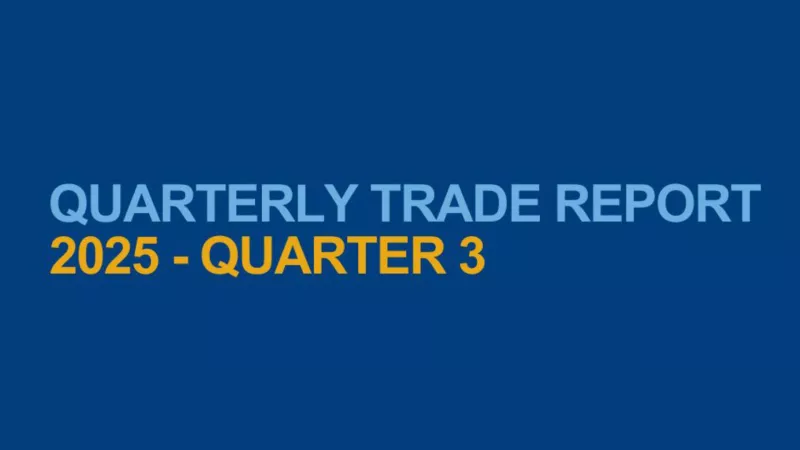
Anchor's away: PLA team removes object from bed of the River Thames

Divers employed by the Port of London Authority (PLA) helped remove a giant anchor, lodged in the bed of the River Thames near Gravesend (9 February).
The exact age of the iron anchor - measuring over 15 feet in height and weighing more than five tonnes - is a mystery.
It’s presence deep in the tidal Thames’ muddy waters was confirmed by routine surveys of the river bed, undertaken by the PLA’s hydrographic team, using a high-resolution multi-beam sonar, to identify changes in the river bed and objects that could pose a navigational risk for vessels.
Divers Ryan Pearce and Jason Durkin were deployed on the river on consecutive days, tasked with salvaging two submerged items with the potential to obstruct river traffic.
The anchor was top of their list of items to remove from the Gravesend Reach.
On Thursday (10 February), they turned their attention to a smaller, rectangular pile, which proved trickier to locate in the pitch-black waters, and required brute force to dislodge it from the bed of the river.
Ryan, a diver since 2008, explained: “You can’t see anything down there; you have to work by touch.”
A PLA crew aboard London Titan returned both the divers’ finds safely back to dry land.
Related content


Location: London/Gravesend Remuneration: £28,971 per annum for a commitment of up to 24 days per...

Inspired by a childhood love for the Thames
Scarlett Barnett-Smith

Ahead of National Apprenticeship Week (7-13 February), Gillingham’s Scarlett Barnett-Smith charts how a PLA apprenticeship launched her career afloat, inspired by a childhood love for the Thames.
From the river to the high seas
“I’ve always felt so lucky to be able to train and work on one of the most famous - and in my opinion, beautiful - rivers in the world.
“I feel totally at home on the water, aboard great vessels, meeting great people.
“My introduction to the Thames was via the Royal Yachting Association.
“As a child, I was very privileged to do a lot of sailing in the Mediterranean. It is where my maritime passion began.
“I love sailing. Just the feeling of being afloat and underway has always made me feel so happy."
A dream come true
“When I left school, I decided I wanted to look for a job on the river.
“I was always told to do what you love. My parents, sister and cousins are all hairdressers, and they all love what they do. They followed their dreams and I have followed mine too. Just mine has been down a very different path.
“It’s been roughly three years now since I started at the PLA.
“When I left school, I decided I wanted to look for a job on the river.
“It’s roughly three years now since I started at the PLA.
“The day I passed my boat masters exam, 12 November 2020, is etched in my memory. It was the best day of my life.
“I put a lot of pressure on myself, but all the hard work paid off in the end.
“It led to the PLA and Trinity House sponsoring my current cadetship at Warsash Maritime School, part of Solent University in Southampton.
“In my first year on the course, I have already seen and learnt so much.”
Inspirational mentors
“I’ve had the benefit of some amazing teachers.
“It was the late Alex Hickman, former training manager at the Company of Watermen & Lightermen, who first talked me through the career options available on the river. He is much missed.
“I also owe a huge debt to Rachel De Bont, my training officer at the PLA and my role model.
“The dedication Rachel shows in helping her flock meet their goals is unbelievable. We keep in close touch.”
A woman on the water
“Throughout my apprenticeship, I attended a lot of events to promote maritime careers to other women, through the Thames Skills Academy and the Women on the Water network.
“I think it’s so important to have a more diverse maritime workforce.
“At times, I’ve found it challenging, being in such a male-dominated industry.
“Fortunately, things are changing for the better and more women are actively applying for apprenticeships afloat.”
Student
“My cadetship consists of five phases, over three years. I do two phases at sea and three at college.
“I am required to have spent 12 months at sea before sitting my oral examination at the end of my course.
“Learning online due to the pandemic has been challenging at times, but Warsash have made it enjoyable and effective.
“It has been lovely being near the water, which has really helped me concentrate.
“I now have my Inland Waterways Diploma and received first-class training from SeaRegs, gaining a number of other qualifications.
“Of course, there’s still a lot I need to learn, but I feel grateful for my PLA apprenticeship.
“It gave me a massive helping hand.“
Seafarer
“It’s been one of my goals for a long time to crew a Trinity House ship, so I was over the moon last year when my cadetship took me aboard THV Galatea.
"With Trinity House vessels, I have sailed round much of the UK’s distinctively unique coastline. I was particularly struck by the beauty of the east coast.
“Next, I became the first ever Merchant Navy deck cadet to deploy with a Royal Navy ship.
“We sailed from Portsmouth to Hawaii, on HMS Tamar. We crossed the Atlantic Ocean, the Caribbean Sea, then the Pacific Ocean, stopping in Curacao and San Diego on the way.
“After five months onboard, I then joined the THV Patricia, which was anchored in the Thames Estuary.
“Being back on the Thames on board a ship as a cadet, and not an apprentice, was a very special feeling.”
Far from home
“I can’t explain how it feels to live, eat, work and do everything with the same people, for months on end, on a ship, miles from home.
“I really value the friendships I’ve made while being part of different crews.
“It can be really difficult to keep in touch with friends and family back home when at sea.
“I spent my 21st birthday in the mid Atlantic.
“Not being able to call home was hard, but I celebrated in a way, completely out of the ordinary.
“I always particularly look forward to getting back home and a cuddle from my dog Dolly, a poochon.
“No matter how long I am away, she always remembers me when I knock at the door.”
Career goal
“My absolute dream would be to return to my roots on the River Thames and be a pilot, guiding larger visiting vessels in and out of port.
“I am going to do whatever I need to do to make it happen.
“Evan Simkus, a PLA pilot, was really helpful to me when I started my journey at sea.
“By chance, we passed on the Thames Estuary, when I was onboard THV Galatea and he was piloting a cargo ship. It was brilliant to see an old colleague, from ship to ship!”
Top tips
“If you’re considering a maritime apprenticeship, just apply.
“It was the best decision I ever made.
“There was not one day throughout my apprenticeship when I woke up and didn’t want to go to work.
“I loved every single minute of it."
Quick fire
- Favourite part of the Thames? Albert Bridge. For starters, it’s pink, my favourite colour. It lights up so beautifully at night.
- Sailing bucket list? The Suez Canal.
Related content


Location: London/Gravesend Remuneration: £28,971 per annum for a commitment of up to 24 days per...

A lasting legacy for Mark Towens, PLA Harbour Master

Few of Mark Towens' many friends and colleagues from across the river community had any idea that he was battling resurgent skin cancer, when he welcomed Prince William to the launch of the tidal Thames’ first-ever drowning prevention strategy in May 2019.
First diagnosed in 2005, shortly before his marriage to his “rock”, Claire, Mark had, with typical drive and determination, resolved to fight his illness every step of the way. With the constant support of Claire, his family and friends, he did just that.
As inaugural chairman of the Tidal Thames Water Safety Forum, he came to see the multi-agency work to tackle accidents and suicides on the river as his legacy and had personally secured the duke’s support.
Mark was characteristically humbled and deeply appreciative of the campaign to raise money for specialist treatment of his condition, which reached its target in a matter of weeks last year.
His only route for the treatment in Tel Aviv was a flight for Israeli nationals trapped in Europe by COVID-19 restrictions. On landing, he and Claire had to persuade the airport officials to allow them to go direct to hospital rather than go into quarantine.
Born in 1981, Mark lived in Northfleet for the first 18 months of his life, before moving to Gravesend.
A star pupil at the town’s grammar school, motion sickness cut short his dream of being an airline pilot.
He joined the PLA in 1999 as a marine apprentice, becoming ports marine surveyor in 2005. He rose through the ranks and was appointed harbour master in 2014, aged 32.
He had taken particular pride in helping to organise HM The Queen’s Diamond Jubilee pageant and was a key player in arranging other milestones in the river’s calendar, including the Boat Race and the New Year’s Eve fireworks.
Throughout his career, he made special efforts to mentor young trainees following in his footsteps, inspiring respect and loyalty from them for his commitment and leadership.
Balancing both family life as a father and a recurrence of his illness, he secured a university MBA with customary aplomb.
Mark combined a direct, no-nonsense style with infectious good humour and charm, even when his health was deteriorating.
A desire to always do his best was second nature for him.
As a proud member of the Company of Watermen and Lightermen and Globe Rowing Club, he came second in the 2004 Doggett’s Coat and Badge Race, much to his annoyance.
His teams triumphed nine times in the traditional Thames Barge Driving Race, staged annually between Greenwich and Westminster.
He approached all team pursuits with PLA colleagues with limitless competitive zeal; from crazy golf to ice skating and white-water rafting, victory was always in his sights.
An insatiable thirst for adventure also took Mark on sailing expeditions around the world, including aboard the tall ship Winston Churchill, from the Canary Islands to the Azores.
Cycling, another of Mark’s passions, led him to complete numerous charity bike rides.
A love of American cars, shared with his father, inspired them to import a 1967 Chevrolet Camaro from Florida.
Mark was also a keen fisherman.
Family was particularly important to Mark. When his illness became terminal, he made the most of the opportunity to spend time with his closest relatives, regularly embarking with them on trips and adventures for as long as he could.
He celebrated his 40th birthday with a family dinner at the top of The Shard, overlooking his beloved river.
As his medical condition worsened, it was Mark’s last wish to spend Christmas at home with Claire and his children, Jamie and Katie, which he managed to do.
Following his funeral in Gravesend, (27 January) tug boats on the river staged a water canon display as a mark of respect.
Mark died on New Year’s Day.
He will be much missed by all who knew him.
Related content


Location: London/Gravesend Remuneration: £28,971 per annum for a commitment of up to 24 days per...

Minister hails drive to boost Thames safety

A drive to maintain tidal River Thames workers’ skills throughout their careers has been hailed by the UK maritime minister as a model for the rest of the country to follow.
Meeting river workers on the Thames in central London (25 January), Robert Courts MP described the Thames CPD (Continuous Professional Development) programme, led by the Thames Skills Academy (TSA), Port of London Authority (PLA) and Company of Watermen & Lightermen as “an exemplar for ensuring that safety is at the heart of greater use of the nation’s inland waterways.”
Boat operations on the tidal Thames, the UK’s busiest inland waterway, are set to accelerate rapidly over the next decade. The boom in online shopping, linked to the pandemic, has generated unprecedented interest in using the river for the transportation of light freight and parcels. The river’s network of passenger piers is also expanding eastwards.
From early 2024, Thames CPD will be mandated by the PLA for all tidal Thames boat masters, from Teddington to the North Sea.
To encourage early-sign up to Thames CPD, by lowering costs, the PLA has launched a five-year investment programme of over £150,000 to roll out a two-day course at HR Wallingford in Oxfordshire, developed by the TSA with employers, to ensure boat masters can contend with a variety of scenarios, at the helm of a virtual vessel. It mirrors long-established training in the aviation industry and other sectors, putting workers through their paces in a safe setting. The programme was established by Tideway, the company managing the construction of London’s “super sewer”, due for completion in 2025.
Robert Courts said: “I salute all the partners involved in the Thames CPD programme for their drive and determination to make it a reality.
“It is a really significant step forward in ensuring that the nation’s premier waterway is a global beacon of best practice.”
Christopher Rodrigues CBE, whose six-year term as PLA chairman ends this spring, explained:
“I am proud to conclude my time at the PLA with this Thames CPD programme in place. It will help underpin safety on an increasingly busy river and sustain the skills of the Thames’ workforce for years to come.
“Though the river may sometimes appear slow-paced and traditional, the reality is starkly different. Technology, Net Zero and increased opportunities for commercial and leisure use all mean the river is changing faster than ever before, making a robust, long-term approach to CPD absolutely imperative.”
Katherine Riggs, chief executive of the TSA, said: “The pace of change on the river is getting faster all the time, making it essential for mariners to keep skills up to date with all the latest developments through CPD, to help keep the river safe and prosperous.
“The new Thames CPD programme will help workers at the helm of boats to access training on all aspects of river operations and ensure their skills remain relevant, meeting employers’ needs.”
Derek Mann, master of the Company of Watermen & Lightermen, commented: “Thames CPD provides a structure for training of the Thames’ workforce, enhancing the high standards already in place and firmly underlining the value of the river as a place of work, for current and future generations.“
Employers supporting the programme include City Cruises, Cory, GPS Marine, Walsh, Livett’s Group, Tideway, Transport for London/Woolwich Ferries and Uber Boat by Thames Clippers.
Details of the Thames CPD programme are available at: ThamesCPD.co.uk.
Related content


Location: London/Gravesend Remuneration: £28,971 per annum for a commitment of up to 24 days per...

New tanks for cleaner fuels speed PLA progress towards Net Zero
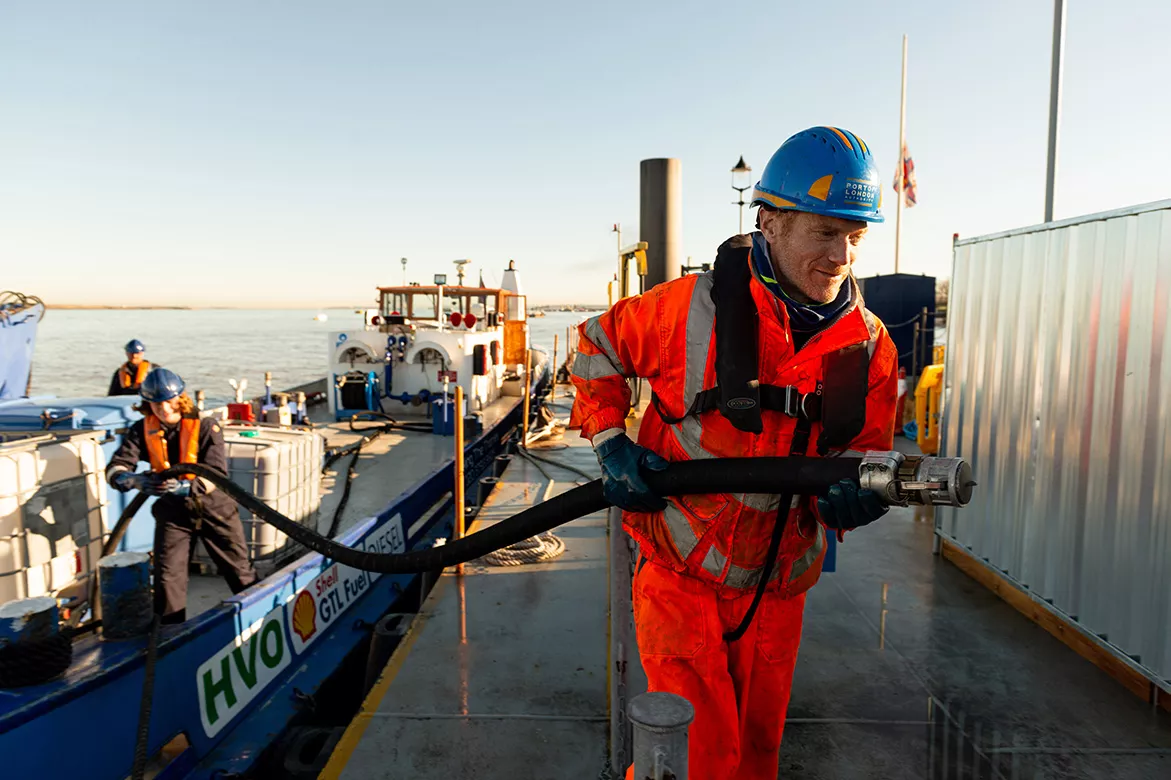
New biofuel storage tanks, installed by the Port of London Authority (PLA) on the Thames in Gravesend, are accelerating an ambitious plan to halve its carbon emissions.
Part of a commitment to achieve Net Zero by 2040, a pair of three-tonne, steel tanks, installed out of sight at Royal Terrace Pier, next to the PLA’s London River House headquarters, have a capacity to store 20,000 litres of pollution-busting hydrotreated vegetable oil (HVO).
By 2025, the PLA is targeting a 50% reduction in the 2,054 tonnes of carbon emitted across its entire operations in 2014. Currently, fuel used by its vessels is responsible for more than 75% of the PLA’s total carbon emissions.
Two more similar tanks for storing green fuels are due to be installed at Barrier Gardens Pier in Woolwich this spring, completing a major refurbishment to make it both safer and more sustainable.
Steven Clapperton, who leads the PLA’s newly-created directorate of Sustainable Marine Operations, said: “This is a major step forward in our plan to decarbonise our round-the-clock work to keep the tidal Thames safe for all its users, from Teddington to the North Sea.
“The introduction of HVO is positive news for both carbon emissions and air quality.
“Our trials show it reduces emissions of nitrogen oxides and particulates by at least 50%, compared to conventional diesel.”
Thames Marine Services Ltd (TMSL) has been appointed as the PLA’s HVO supplier, following a competitive tender process. Business director Robert Dwan said: “We are proud to be at the forefront of work to minimise the river’s carbon footprint.
“Supplying all types of vessels - from house and passenger boats, to tugs, container and navy ships - we have invested to modify our barges to carry more environmentally-friendly fuels.
“We aim to help all our customers on the journey to Net Zero, which is so important for the long-term health and prosperity of the river and all those who rely on it to make a living.”
Contractors Taylor Fuel Controls and ET Marine have helped the PLA design and install the new tanks.
NOTE FOR EDITORS
Trials conducted by the PLA showed HVO cut nitrogen oxide emissions by 51-78%, compared to gas to liquid (GTL), and particulate matter by 76-99%, compared to 50-93% for GTL.
Related content


Location: London/Gravesend Remuneration: £28,971 per annum for a commitment of up to 24 days per...

Active Thames fund winners announced
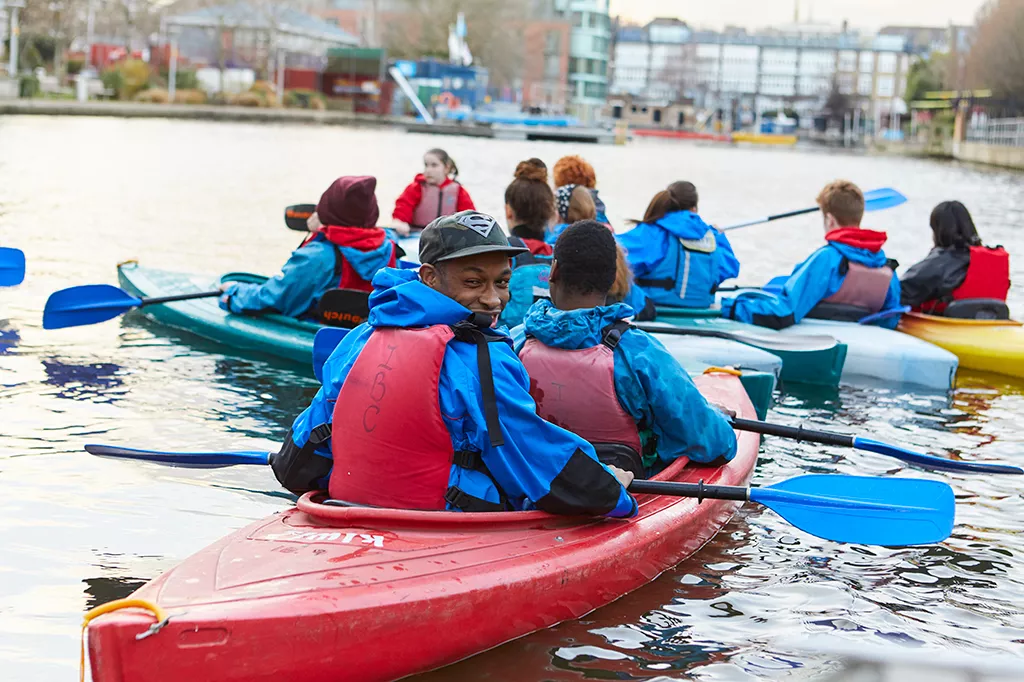
More than £90,000 has been awarded to 24 organisations promoting activity on the tidal Thames and inland waterways in London, Kent and Essex, as part of a new programme led by the Port of London Authority (PLA).
The recipients of the Active Thames grants include clubs from Richmond in the west, through Wapping and Tower Hamlets in the centre of the capital and out to Gravesend and Shoeburyness in the east.
Active Thames aims to encourage groups that are less likely to engage in physical activity on the river, including individuals from ethnically diverse communities, lower socioeconomic groups, and those with disabilities.
In a survey last year, people involved in watersports across the region voiced their desire to see improvements in diversity and inclusion, and there was a high demand for coach and volunteer development.
The Active Thames partners working to better serve the watersports community include Active Essex, Kent Sport, London Sport, British Canoeing, British Rowing, RYA, Canal & River Trust, Thames Path National Trail and the PLA.
Jenny Cooper, PLA sports manager, said: “Active Thames is supporting access, diversity and inclusion in sports and every recipient is ambitious about making watersports open to all.
“The grants will see new communities on the water in London, Kent and Essex and will help develop the next generation of coaches and volunteers.”
Chris Earle, head of recreational paddling at British Canoeing, said: “British Canoeing is excited to be collaborating with Active Thames to support clubs tackle inequalities and increase participation within communities alongside the waterways of the Thames.
“By co-creating opportunities to overcome barriers to participation we are confident that our investment and support will result in sustainable activities which provide equal access to opportunities in inclusive, fun, safe, and accessible environments.”
Islington Boat Club’s grant will fund crucial training for instructors and volunteers while Royal Dolphins Rowing Club will be able to provide taster sessions to more disabled people in east London.
Active Thames is a key part of the Thames Vision 2035 river development framework. Making it possible for more people to get afloat and active on the river is one of the Vision’s six main goals.
Find out more at activethames.co.uk.
A full list of the 24 recipients:
Black Girls Hike UK provides a safe space for black women to explore the outdoors. £1000 will subsidise paddling sessions in East and South London this summer, and signpost to local clubs and coaching courses. (London)
Blue Therapy Active will use £5000 to purchase kayaks, safety equipment and clothing and provide weekly paddling sessions at Southend on Sea, Two Tree Island, Shoeburyness and Chalkwell. They intend to reach more women and encourage them to become coaches and will work with people signposted from local mental health organisations who are looking to return to exercise and improve their overall health and mindset. (Essex)
The Bluetits Chill Swimmers is a social enterprise committed to empowering a community of cold water swimmers. One group benefiting from the funding is regularly active in Whitstable. 80% of the group are female and over half joined in order to experience the health benefits of cold water therapy and sea swimming. £940 will provide training for the founding members so that they can tackle their waiting list, and support more people to enjoy cold water swimming safely. Active Life Ltd are providing this training and helping support the club’s development. (Kent)
Chelmsford Canoe Club have been awarded £4671 and will be spending their funding on the provision of new boats- sit-on-top kayaks. The club feels confident that this type of boat will get people involved more quickly and safely, combatting any concerns around Covid-19 or fears of getting trapped. It will help the club tackle their lengthy waiting list. The club also intends to run river clean ups in the summer. (Essex)
Following a successful pilot in 2021, £5000 will support Cody Dock Environmental Canoe Club to run regular paddling sessions with river clean-ups and citizen science environmental survey safaris. New audiences will be called to action via a different purpose - the environment. The club has a community engagement lead who ensures activities are as inclusive as possible and that their reach is representative of Newham and Tower Hamlets. (London)
Danson Park Adventures had an incredibly busy summer in 2021 with sailing and paddlesports courses all fully booked. £2000 will provide bursary support for coaching qualifications for young people on Danson Lake in Bexley and on the Thames. (London)
Dittons Paddleboarding Club run free community paddlesports sessions on the Grand Union Canal and the Thames. £1500 will train volunteers in first aid and water rescue, so they can increase the number of free sessions on offer. Dittons have a keen desire to make paddlesports a more inclusive and diverse sport. (London)
Fulham Reach Boat Club provide rowing for all. £5000 will support learn to row courses for secondary school pupils in Hammersmith and Fulham and broaden the appeal and accessibility of rowing and the great outdoors now and into the future. (London)
Globe Rowing Club aim to diversify their club by attracting and retaining more people from ethnic minorities, young people and women. Like many clubs, they do not have enough coaches. £4000 will enable Globe RC to attract, retain and develop coaches and reach new audiences. (London)
Gravesend Rowing Club need an engine for their safety boat. A grant of £3300 will allow the club to deliver rowing courses over the winter and provide adequate safety cover for activity sessions for local schools and community groups. (Kent)
Gravesend Sailing Club want to make sailing more accessible to the local community and have organised regular dinghy taster sessions. £2000 will support the training of Dinghy instructors, helping to get more people out on the Thames in Kent. (Kent)
Herne Bay Sailing Club are an RYA Sailability and RYA training centre with proven success in working with people who are visually impaired and with people who are deaf. They intend to use £5000 to purchase equipment to support their work and keep costs as low as possible. (Kent)
Islington Boat Club on the Regents Canal is a charity providing boating, personal development, health awareness and employment training to children, people with disabilities, schools and youth groups and the Upper Deckers club provides potentially isolated older people with free activity sessions. Canoeing, kayaking, powerboating, sailing, narrowboating, bell boating and mountain biking, as well as off-site days and residential trips, are all on offer. A grant of £4943 will provide crucial training for instructors and volunteers, supporting their continuation of their community engagement and the work of the charity in Islington. (London)
Laburnum Boat Club is a multisport charity in Hackney working with disadvantaged and disabled young people. £4815 will support kayak, canoe and SUP day trips on the tidal Thames and inland waterways, and the mentoring and qualification pathway running alongside sessions will support the overall wellbeing and development of each child. (London)
London Sports Trust will use £4400 to support a new programme, Changing the Tide. The programme aims to use the proven combination of watersports, positive role models and continued learning opportunities to improve the health, wellbeing and employment prospects of some of the most vulnerable teenagers from deprived housing estates. Kayaking, canoeing and coach development will be on offer at Thames-based sites Cremorne Wharf and Fulham Reach. (London)
London Youth Rowing provide opportunities for disadvantaged young people to experience the benefits of rowing through a range of coaching, inclusion, and health programmes. LYR have just started to deliver watersport on the Olympic Park in East London and will partner with Active360 to create multi-skilled watersports coaches, and help address the current shortage of SUP trained coaches in East London. A grant of £8010 will support coach development and provide equipment in order to help open up watersports with a particular focus on young people, people from minority ethnic backgrounds and people from lower socio-economic backgrounds. (London)
Newham Ability Camp is a pan disability multi sports club that runs three sessions a week for young people with disabilities. Sports offered include cricket, basketball, badminton, archery, football, boccia and softball and with a grant of £742 will support the club to access rowing sessions, provided by experienced coaches at London Youth Rowing. Many parents reported a worrying deterioration of their child’s mental health during lockdown with depression, becoming withdrawn and behavioural issues associated with extreme anxiety. Being back together in the club and taking part in sporting activities like rowing will help the children rebuild their confidence and mental wellbeing. (London)
Phoenix Canoe Club is located next to the Welsh Harp reservoir which borders Barnet and Brent. They offer kayaking, sailing, canoeing, SUP and bell boating to a range of community groups and are currently working with Mencap, Mind, disability groups, and with organisations specialising in disadvantaged and ethnic minority participants and refugees. £5000 will support the continued delivery of sports sessions and provide disability training for staff. (London)
The Royal Dolphins Rowing Club is a disability rowing group based at the Royal Docks Adventure in Newham. A grant of £3172 will go towards upskilling coaches and the provision of taster sessions for more disabled people from across East London. Members will be able to make new friends, become part of a new community, take part in a regular physical activity, and improve their physical and mental wellbeing. Growing the Royal Dolphins will raise the profile of adaptive rowing in East London. The Royal Dolphins are currently supported by the Royal Albert Dock Trust and London Youth Rowing and have competed in events such as the Great River Race. (London)
Sea-Change Sailing Trust provide residential voyages on an engineless sailing barge- the Blue Mermaid- on the Thames Estuary. They seek out young people who have experienced some disruption or disadvantage in their lives. When onboard, young people live and work together; learning to handle the sails, steer the barge, climb the rigging, cook, and clean. As well as the nautical skills they develop skills like resilience, teamwork, respect for others and communication. A grant of £3500 will provide both bursary support for disadvantaged young people in Kent and Essex and staff training to provide the next generation of young leaders and support the succession plan of the trust. (Kent and Essex)
Sport Works and The AHOY Centre have developed an innovative partnership which aims to engage disadvantaged groups who have never participated in sailing before. £4762 will allow Sport Works and The Ahoy Centre to deliver sailing sessions for disabled people. Participants enjoying sailing on the Thames will be recruited from local special schools and adult day centres, and the local councils Disabled Children’s Teams and Adult Social Care teams will actively refer into the project. (London)
The Thames Barbarians Pilot Gig Club is one of the newest clubs on the Thames. £2500 will support club development with cox training, masterclasses, coach development, safety and seamanship. It will also support taster weekends for the local community and introduce Cornish Pilot Gig rowing to the Kent community. (Kent)
Tower Hamlets Canoe Club are excited to be launching a programme for blind and visually impaired adults to enjoy canoeing at Shadwell Basin, a potentially pioneering model for other clubs around the county. £5000 will support coach training, equipment and provide bursary support so that sessions are provided at a low cost to individuals. The club will work with Metro Blind Sport and British Canoeing to find their audience and promote this offer. (London)
Wapping Youth FC are looking forward to creating a new group of paddlesports community at Shadwell Basin Outdoor Activity Centre, a charity in East London. Working with partnering communities from low socio-economic backgrounds and with the council to identify at-risk young people, Wapping Youth FC are looking to create an inclusive paddlesports group and will also focus on initiating conversations about mental health. £5000 will support their paddlesports sessions. (London)
Related content


Location: London/Gravesend Remuneration: £28,971 per annum for a commitment of up to 24 days per...

A constant thread
The Very Reverend Andrew Nunn
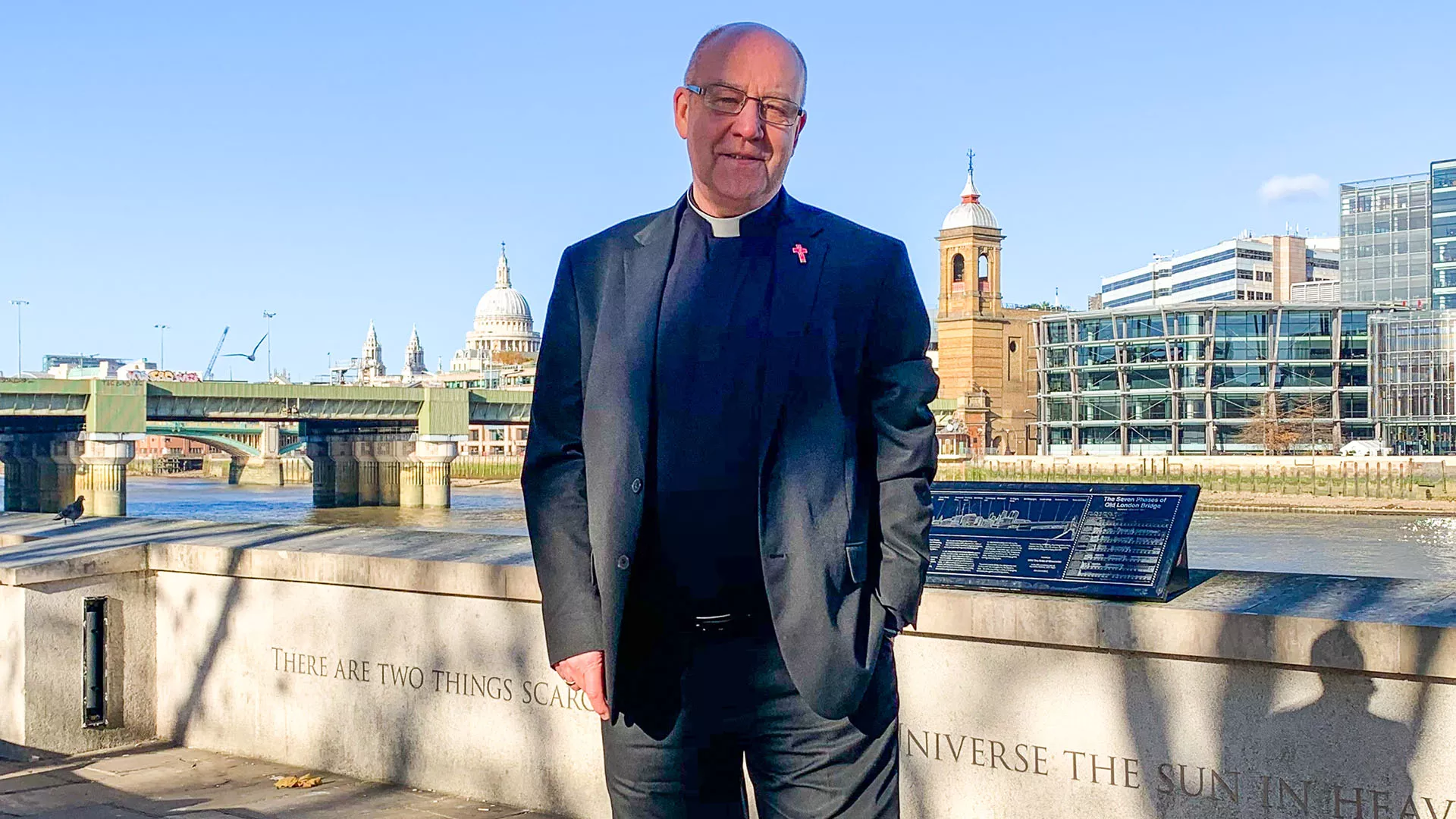
Serving a community still scarred by the The Marchioness disaster over 30 years ago, the Thames is a constant thread through the life of the Dean of Southwark and his cathedral's diverse congregation – not least over Christmas and New Year.
Midlands born and bred
“Leicester is my home city. I studied for my first degree there too.
“I first came to London on a school trip – to The Science Museum, or something like that, but we must have gone to the river as well. I remember being so impressed by its size.
“It was so different from the rivers back home.”
Priestly origins
“My mum was a church goer, my dad not so much.
“After the initial surprise, when I eventually told them that I wanted to be a priest, they were both very supportive.
“The realisation that God wanted me to work in the church came to me as a 14-year old choirboy, when I was on my way to evensong.
“I had three wonderful years training for the priesthood at a monastery in Mirfield, Yorkshire. It’s where the Community of the Resurrection is based.
“Whilst I was there, I also read theology at Leeds University.”
Career path
“My first paid job was actually folding shirts in a factory in Leicester for Marks & Spencer.
“Before I went off to train to be a priest, I also worked as a door-to-door rent collector in Wellingborough.
“My religious career started as a priest near Leeds.
“I have been at Southwark Cathedral for over two decades now, joining the Diocese of Southwark in 1995, as Chaplain to the Bishop.
“That is a very long time, but it still feels exciting.”
Day to day
“Genuinely, no two days are ever same.
“I love the fact that every day is different.
“I get to meet such a wide variety of people and do some really interesting things – such as answering questions for the Port of London Authority!
“My first degree was in public administration, so the more mundane aspects of my job don’t particularly bother me.
“I suppose what I don’t like so much is conflict.
“For the most part, we all get on very well, but as in any community or organisation, there are always challenges.
“Over the years, I have acquired many other charitable responsibilities.
“I am also a member of the General Synod, the Church of England’s legislative body, for example.”
Christmas peak
“In the heart of London, we are a very busy cathedral, with at least five services a day,
“In many ways, Christmas is the busiest time. No surprise there.
“We have so many carol services and concerts.
“Normally we all have a one day off a week.
It’s usually just after Christmas and Easter, that we get to have a longer break.
New year traditions
“Most years, I enjoy New Year’s Eve in the Deanery, looking out across the river with friends over dinner, watching the crowds going backwards and forwards.
“It’s been different during the pandemic, for obvious reasons.
“I do hope that the fireworks come back soon.
“I always think it’s a shame that they don’t utilize the whole river more for the New Year celebrations, as happened at the Millennium.
“From where I am, it’s hard to see round the bend of the river to Westminster.
Serving a diverse community
“Our congregation very reflects much the population of London.
“We pride ourselves on being inclusive, welcoming people from all backgrounds.
“Especially those who traditionally may not feel accepted by the Church.
“One of only two cathedrals in the world that has a chapel to those living with HIV/AIDS, we have a long history of welcoming the LGBT+ community.
“Essentially, we are a parish church, responsible for the pastoral wellbeing of all who live in on Bankside.
“We are not just involved in the religious aspects of people’s lives.
“We also seek to play our part in supporting the wider community, of which we are part”.
“For example, we work very closely with the ROBES Winter Night Shelter, which looks after the needs of local homeless people.”
Good over evil
“The terrorist attacks of recent years have had a profound effect on the local community; not all of it negative.
“It is incredible how such events can bring people together.
“The wounds of the terror attack on London Bridge in June 2017 and the atrocity at Fishmongers’ Hall in 2019 are still open.
An employment hub
“We have around 30 staff on our payroll, with a wide variety of skills, including musicians, accountants and educationalists.
“As with most organisations, the pandemic has had a huge effect on our operations.
“As soon as the first lockdown was introduced, we took our services online.
“That has continued, even though we were able to welcome worshippers back to church in the summer of 2020 and then again in time for Christmas last year.
A living heritage
“The cathedral was founded as Priory of St Mary Overie. following the great Fire of Southwark.
“The nave was rebuilt end of the 19th Century.
“For many years, the tower of what is now the Cathedral, was the highest structure on the south bank.
“It is a complex building, which takes a lot of maintaining.
“Nowadays, we are dwarfed by The Shard.
“It sometimes feels like we in danger of being swamped by new developments all around us.”
Future funding
“Receiving no money from the state, we are reliant on our own fund-raising initiatives.
“We have a very generous congregation, have developed our own strong trading function, and also benefit from numerous grants and donations.”
A place of sanctuary
“My favourite part of the cathedral is the Retro Choir.
“It was the first part of the building to be re-built following the Fire in 1212.
“It is very Early Gothic and has a very special feel to it.
“Sadly, I suspect that many Londoners are completely unaware of it.”
The river
“Since the founding of the first convent on the site in c. 606, the church has had a close relationship with both the river and London Bridge.
“The Thames is a reassuring and constant presence for the whole cathedral community.
“For the past few years, on the second Sunday of January, the Feast of the Baptism of Christ, we have joined with St Magnus the Martyr from the north shore, for a river blessing ceremony.
“It’s an annual highlight for me; an important opportunity for all those who use the river, whether for work or for leisure, to pray for its wellbeing.
Indelible scars
“The Marchioness memorial is sited at the west end of the cathedral.
“It’s a special place, where the family and friends of those who died in the disaster can come and remember their loved ones.
“Each year on the anniversary of the tragedy, the names of those who perished are read out in the cathedral.
“For all those who survived, the memory of what happened that fateful night is an ever-present reality.”
A changing environment
“There is a lot more traffic on the Thames, compared to when I first arrived.
“It is good to see a lot of people using the river as a means of getting around London.
“Obviously, there are an increasing number of party boats.
“They can cause huge disturbance to the lives of those who live alongside the river.
“I know that this is an issue that the PLA and others have to deal with on a regular basis.
“We look forward to working with the PLA and other partners on the river to make our operations carbon neutral by 2030.
“That will involve making sure that boats on the Thames also use cleaner forms of energy
“It’s very clear to me, river transportation has an important role to play in moving goods and people around the city more sustainably.”
Quick fire
Three words that encapsulate the river for you?
Ever-changing. Dynamic. Beautiful.
Favourite Thames view?
“I love crossing Waterloo Bridge in the evening, when the buildings on either side are illuminated, and the river is looking at its very best.
“I particularly looking across to our cathedral neighbours on the northern foreshore at St Paul’s.
“Thanks to the Illuminated River project, the Thames is now be-jeweled from dusk, in both directions. Quite simply, it’s spectacular.”
Best Thames-side restaurant or pub?
“It’s hard to choose; I can thoroughly recommend The Swan at The Globe.
"Pizza Express on Bankside is also a fun destination.
"The Founder’s Arms, close to Blackfriars’ Bridge, is a favourite too.”
Other interests?
“I adore walking around London, all year round.”
Related content


Location: London/Gravesend Remuneration: £28,971 per annum for a commitment of up to 24 days per...

Smarter navigational technology for a busier river
State-of-the-art, air traffic control communication technology is helping the Port of London Authority (PLA) improve navigational safety of visiting vessels on the tidal river Thames.
A modernisation programme, focused on maintaining safety on an increasingly busy river, has seen the installation of cutting-edge equipment at the PLA’s navigational control centres in Gravesend and Woolwich.
Used widely at airports around the world the technology, developed by Rohde & Schwarz, has also been applied by one other major world port, Hong Kong.
It will help future proof the PLA’s ability to oversee the safety of vessels on the river, from Teddington to the North Sea.
Bob Baker, the PLA’s chief harbour master, said: “Applying this innovative communications system in a marine context provides us with the resilience and reliability we need to keep the river safe for all of its users.
Earlier this year, London was confirmed as the largest port in the country by volume handled, after a break of over two decades.

Related content


Location: London/Gravesend Remuneration: £28,971 per annum for a commitment of up to 24 days per...

Environment Fund winners announced
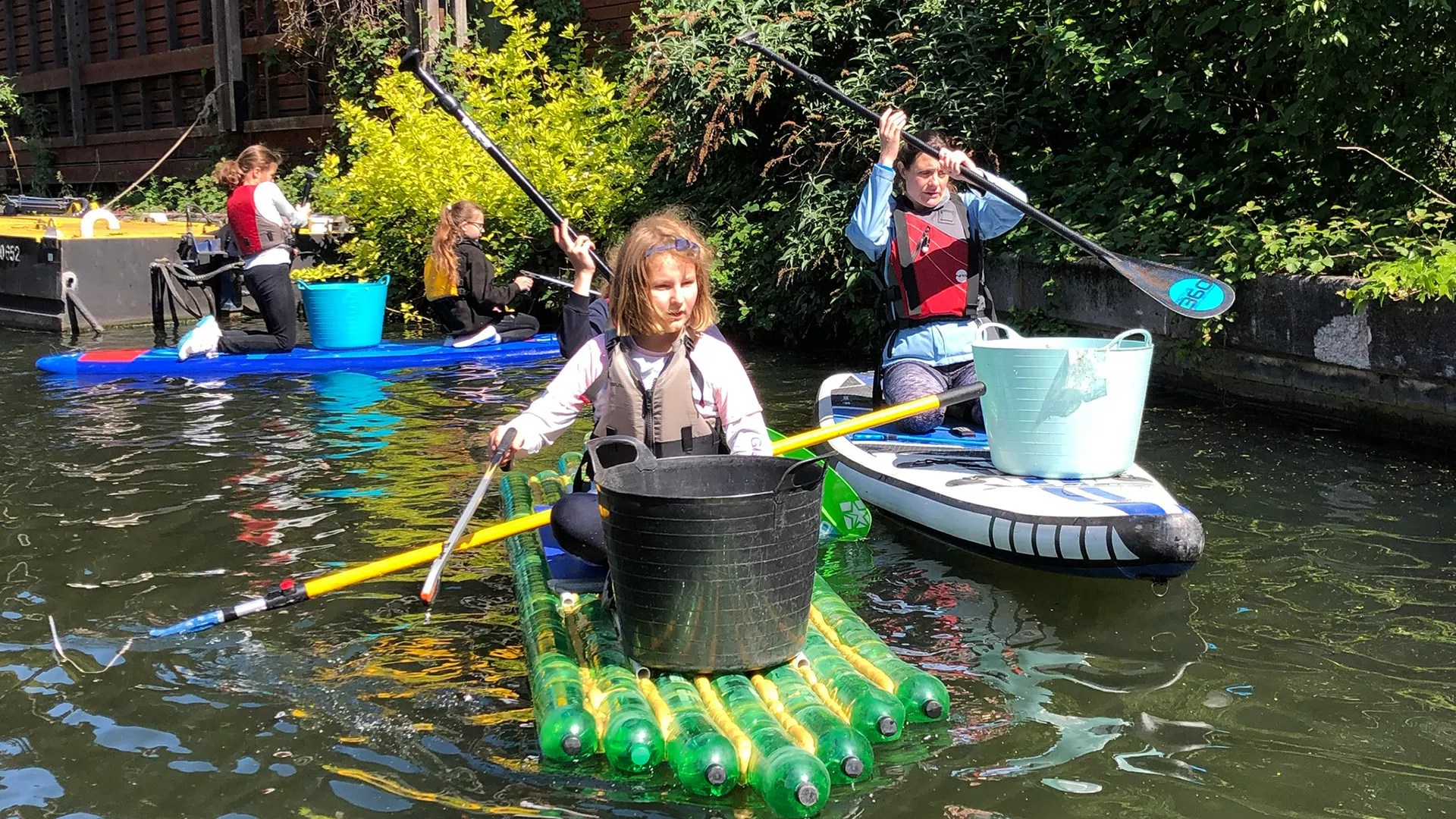
Volunteer projects tackling litter and invasive non-native species (INNS) on the tidal Thames are getting a helping hand from our new Environment Fund.
Applications from five initiatives have secured grants to boost their work:
Dartford & Crayford Creek Restoration Trust
Over the past ten years the trust has transformed Dartford Creek from an abandoned, industrial waterway, into an important green corridor, bringing new life to derelict wharves.
Our grant will help get more volunteers out on to the water, to deal with the legacy of decades of rubbish accumulated in reed beds.
AHOY Litter pickers
The work of Deptford’s AHOY Centre to engage local young people on how they can reduce Thames litter will be boosted by the purchase of new equipment, made possible by our Environment Fund grant.
Litter Pickers aims to highlight the small but impactful individual choices members can make to stem plastic pollution in the river on their doorstep.
“Paddle & Pick”
Our funding will enable the Whale Company and Active360 to reconnect more children with the Thames, London’s biggest open space, through litter-busting, stand-up paddle-boarding (SUP) sessions, combined with a take-away Thames Natural History guide.
Through SUP, this unique project amalgamates wildlife, plastic and immersion in nature
Sheppey Coastbusters
The Isle of Sheppey’s growing population of invasive Pacific oysters (Magallana gigas) - and the dangers posed by their impacts to local ecosystems and razor-sharp shells - are the target of this Medway Swale Estuary Partnership project.
Our award will aid partnership’s work to stem their spread, by implementing control measures, approved by Natural England.
ZSL #OneLess
Our funding will allow a collaboration by Zoological Society of London (ZSL) with citizen scientists to investigate the life cycle of plastic litter in London while recruiting a greater diversity of volunteers in local communities.
Their work will replicate methodology successfully implemented in the Ganges and Mississippi river systems, in the iconic River Thames.
Head of Environment, Tanya Ferry, said: “We are really excited to support a number of organisations to tackle the challenges facing the Natural Thames now and for the future, through projects covering education, research and action.”
Related content


Location: London/Gravesend Remuneration: £28,971 per annum for a commitment of up to 24 days per...

Discover
